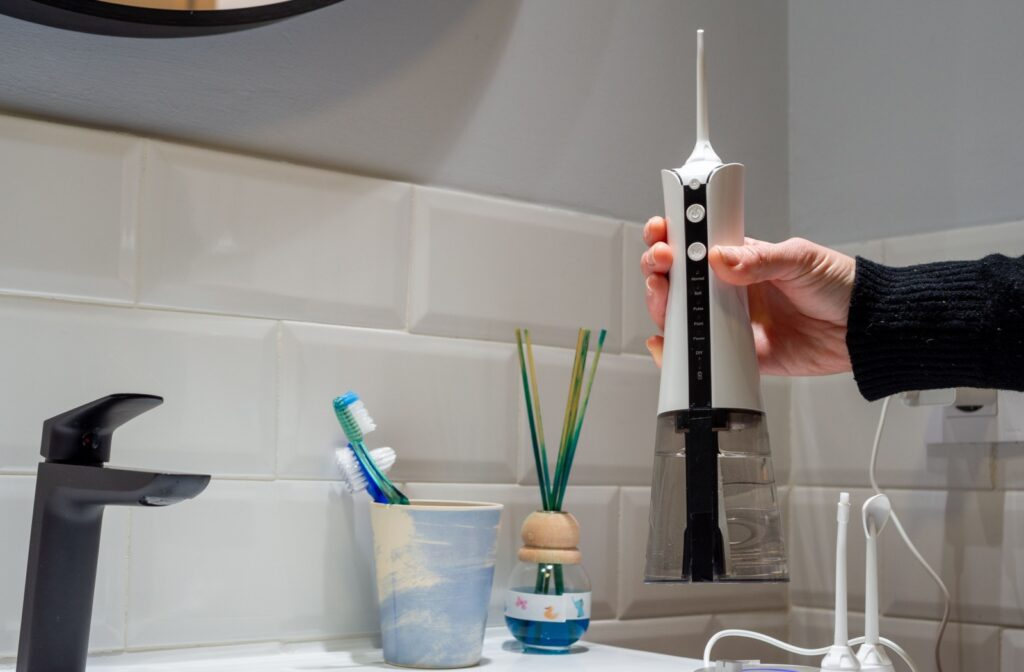How to Floss Your Back Teeth: A Step-by-Step Guide

Many of us have a solid brushing routine, but those back teeth can sometimes feel out of reach when it’s time to floss. However, taking the time to clean between your molars is a key step in maintaining your comprehensive oral health and an important part of gum disease prevention.
With the right C-shape technique, a few simple tips, and helpful tools, you can effectively clean your back teeth and support your overall oral health. This guide breaks down the process into simple, manageable steps. You can build a routine that keeps every tooth, even the hardest to reach, clean and healthy.
Flossing & Dental Health
A consistent oral hygiene routine does more than just help prevent cavities. It’s also a simple, daily practice that supports your overall health and well-being. The small habits you build today can have a positive impact for years to come.
Support Your Gum Health
Flossing removes plaque that your toothbrush can’t reach, especially below the gum line. When plaque builds up, it can harden into tartar and lead to gum irritation. Daily flossing helps keep your gums healthy and can also reduce bad breath.
Connect Oral Health & Overall Health
The health of your mouth is closely connected to the health of your body. A good oral care routine is a proactive step you can take every day for your general wellness. It’s an investment in your smile and yourself.
Why It’s a Challenge to Floss Back Teeth
Your back teeth (molars) have a shape and function that can make them difficult to clean.
Molars are designed for chewing, which means they have wide surfaces with grooves and pits. These features are great for grinding food, but they can also trap food particles and plaque. This makes a daily floss routine important for keeping them clean.
However, the main reason it’s tricky to floss your back teeth is their position. It can be tough to see what you’re doing and it’s not always easy to move the floss around effectively.
A Simple Method to Floss Your Back Teeth
Fortunately, you don’t need to be a contortionist to floss your molars properly. Follow these steps to build a solid routine that works for you.
Get Your Floss Ready
- Cut a piece of floss about 30–50 centimetres long—roughly the length from your hand to your shoulder.
- Wrap the ends around your middle or index fingers, leaving a taut section of about 2 to 5 centimetres between your hands.
Use the Correct C-Shape Technique
- Gently guide the floss between two molars with a soft back-and-forth motion. Avoid snapping the floss down, as this can harm your gums.
- Curve the floss into a “C” shape against the side of one tooth.
- Slide the floss up and down, from the top of the tooth to just below the gum line.
- Repeat on the other tooth before you move to the next space.
How to Know You Floss Correctly
When you floss the right way, it should feel smooth against the tooth and go just below the gum line without any pain.
If you’re new to flossing, a little gum sensitivity is common at first but usually fades as you stick with it.
Common Floss Mistakes & How to Fix Them
Even with good intentions, a few common habits can make flossing less effective than it could be. Here are a few things to watch for and how you can correct them. A small adjustment can improve your results.
Too Much Pressure
Pushing too hard or snapping the floss can irritate your gums. Always use a gentle, controlled back-and-forth motion to protect your delicate gum tissue and prevent long-term gum problems.
What to Do With Stuck Floss
If your floss gets stuck, try not to yank it out. Instead, let go of one end and gently pull the floss through from the side. You might also find that a different type of floss—like waxed floss or dental tape—works better for tight spaces.

Helpful Tools for Hard-to-Reach Molars
If traditional floss feels awkward, especially for your back teeth, you’re not alone. Other tools are available that can help you clean between your teeth effectively. Finding the right tool for you can make your daily routine much easier and is an essential part of a lifelong oral health strategy.
Water Flossers
A water flosser uses a targeted stream of water to wash away food particles and plaque. It can be a very gentle option, which is great for people with difficulty with dexterity. String floss still remains the gold standard.
Interdental Brushes
These are tiny brushes designed to fit right between your teeth. They are simple to handle and can clean wider spaces very well. They come in various sizes to match the spaces between your teeth.
Floss Picks
Floss picks are small plastic tools with a short piece of floss already stretched out for you. Many people find they offer better control and are convenient for cleaning on the go. String floss still remains the gold standard.
Get Personalized Advice
During a check-up, we can show you specific techniques to floss tricky spots like your back teeth. We can also suggest tools that may work well for your unique smile. If you’re looking for a friendly dentist in Ottawa, our team is always happy to help.
Taking a few extra moments to floss your back teeth can make a big difference in your oral hygiene.
We believe in making dental care accessible and comfortable for the whole family. If you’d like to learn more, book an appointment with our team at Dow’s Lake Dental. We can show you what steps you can take to keep your smile healthy for years to come. We look forward to seeing you.


